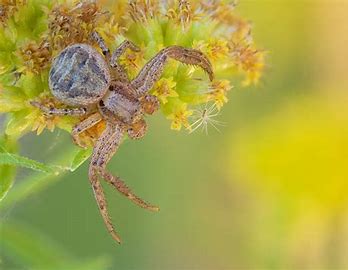Crab Spider
Crab spiders are members of the Thomisidae family. This family belongs to the order Araneae, which includes all known spiders. There are at least 2,000 species and 170 genera. Crab spiders mainly feed on insects along with flowers and pollen and has a lifespan of up to a year (making them annuals), and ranges in size from 0.11 to 1.2 inches (0.27-3.0cm) but most species are around 0.43 in (1.1cm) [1].

| |
| Domain: | Eukaryota |
|---|---|
| Kingdom: | Animalia |
| Phylum: | Arthropoda |
| Subphylum: | Chelicerata |
| Class: | Arachnida |
| Order: | Araneida |
| Family: | Thomisidae |
Description
Crab spiders can generally grow up to an inch in size, with females being much larger than males. They get their name from their uneven legs; the 4 front legs are longer than the 4 back legs which gives them the appearance and movements of a crab. Their eyes are separated into 3 rows with the bottom row containing 4 small eyes, the middle row containing 2 large eyes, and the top row containing 2 medium-sized eyes. This gives them powerful vision that can detect prey, even at night. Their bodies are also covered in hairs that help them detect their surroundings with touch. Crab spiders come in a wide variety of colors including white, black, brown, sky-blue, goldenrod yellow, cherry blossom pink, leaf green and many more. They have flat bodies, two claws, and legs that are held crabwise and allow them to run sideways. This is called laterigrade.[2]
Habitats
Crab or flower spiders are found everywhere in the world save the coldest or driest places. They perch under leaf litter, beneath tree bark, and on plants and flowers. Crab spiders are found in the tropics, temperate forests, deserts that aren’t too dry, and on mountains that aren’t too cold.[3]
Mating and Reproduction
Male crab spiders only come in contact with female crab spiders during their mating season. The male is attracted to the female through the pheromones from the silk they produce. Males will wrap their intended mate with silk to mate with them. After mating is completed, the female constructs an egg sac that she will leave in one spot and protect until the eggs have hatched. Females are very defensive over their egg sacs and show aggressive behaviors to protect them.[4]
Diet
Crab spiders eat mostly insects that land too close to where they are hiding. As ambush predators they attack the pollinating insects that land close to them. Because their venom is potent for a spider of their size, they can capture insects much bigger than they are.[5] These insects include crickets, grasshoppers, and wasps. Other insects include such pests as aphids, thrips, caterpillars, houseflies, fruit flies, whiteflies, other types of flies, and Japanese beetles, but they can also include beneficial insects such as butterflies and bees. Many crab spiders hunt at night such as the white crab spider, Thomisus spectabilis. Others hunt during the day. Because of their small size, crab spiders are typically too small to hurt humans with a bite or venom. Some flower spiders such as Thomisus onustus, the pink crab spider eat the nectar and pollen from the flowers they live on when prey is scarce. Luckily crab spiders do not attack humans and only bite is absolutely necessary for survival.[6]
References
- ↑ Family Thomisidae - Crab Spiders https://bugguide.net/node/view/1957
- ↑ Crab Spider May 27, 2024 https://a-z-animals.com/animals/crab-spider/
- ↑ Crab Spider May 27, 2024 https://a-z-animals.com/animals/crab-spider/
- ↑ Crap Spiders https://spideridentifications.com/crab-spiders
- ↑ Crab Spiders https://www.inaturalist.org/taxa/47866-Thomisidae
- ↑ Crab Spider May 27, 2024 https://a-z-animals.com/animals/crab-spider/
- ↑ Family Thomisidae - Crab Spiders https://bugguide.net/node/view/1957
- ↑ Crap Spiders https://spideridentifications.com/crab-spiders
- ↑ Crab Spiders (Family Thomisidae) https://www.inaturalist.org/taxa/47866-Thomisidae
- ↑ Crab Spiders https://www.inaturalist.org/taxa/47866-Thomisidae
- ↑ Crab Spider May 27, 2024 https://a-z-animals.com/animals/crab-spider/